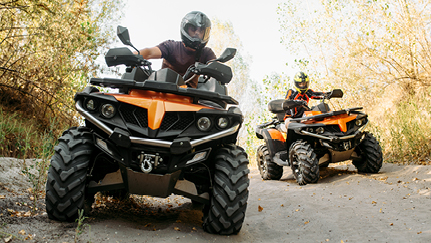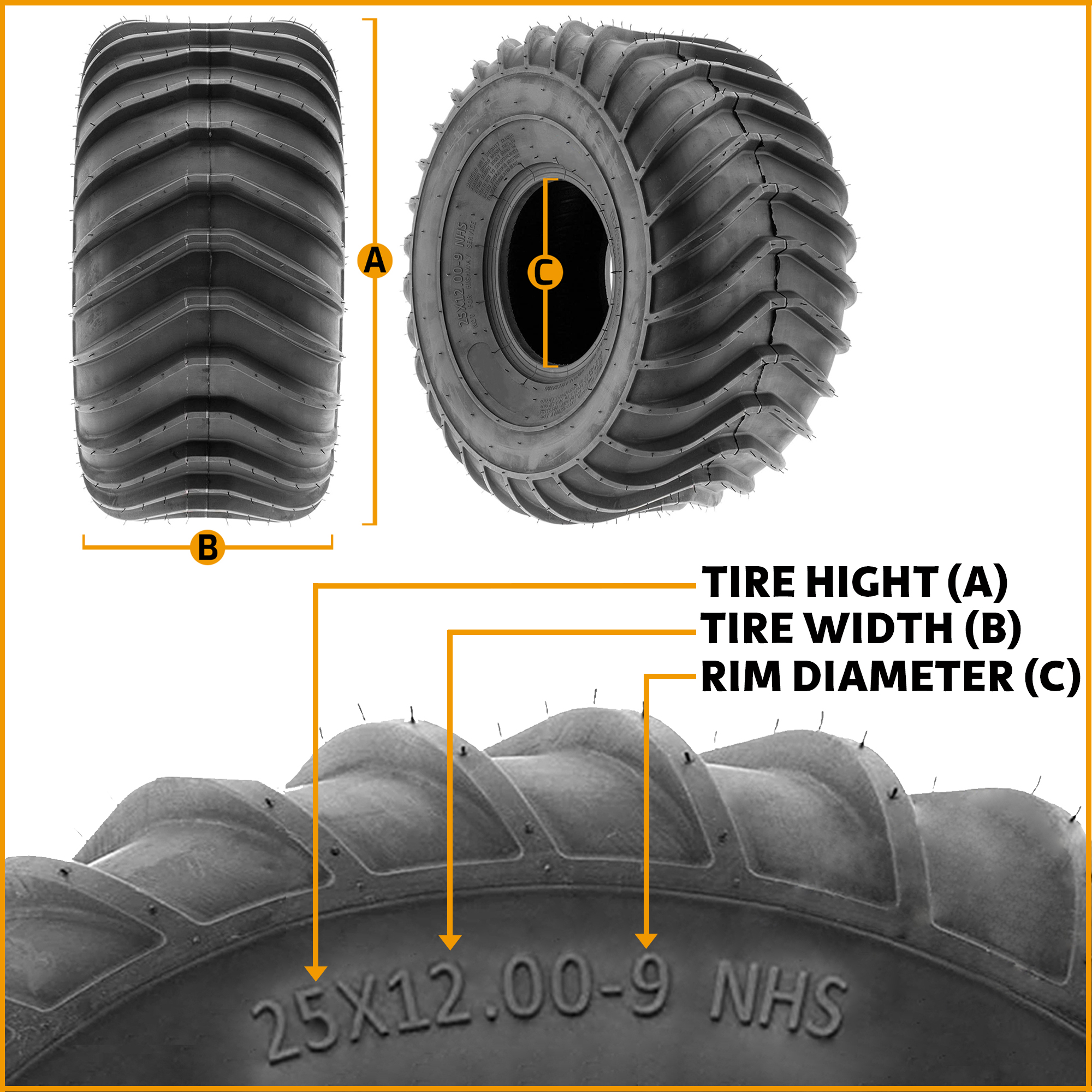Are you a thrill-seeker who loves to explore the great outdoors on your all-terrain vehicle (ATV) or utility terrain vehicle (UTV)? If so, you probably know that the right tires can make all the difference in your off-road adventures.
But have you ever wondered if there’s a real difference between ATV and UTV tires? Choosing the right tires is crucial, not just for performance but also for safety. You want to make sure you’re getting the most out of your ride, whether you’re tackling rocky trails, muddy paths, or sandy dunes.
We’ll dive into the distinct features of ATV and UTV tires, helping you understand which is best suited for your needs. Stick around, because this information could transform your riding experience and enhance your outdoor escapades.

Credit: www.nationwide.com
Atv Tires Vs Utv Tires
ATV and UTV tires may look similar at first glance. They both support off-road vehicles. But they serve different purposes. Understanding their differences can improve your off-road experience. It helps in choosing the right tire for your vehicle. This section explores the key differences.
Purpose And Design
ATV tires focus on agility and speed. They are usually lightweight. This design enhances maneuverability. UTV tires prioritize stability and strength. They are built to carry more weight. UTVs often handle rougher terrains. Their tires need to be more robust. This difference affects their construction. It also influences performance.
Tread Patterns
ATV tires have varied tread patterns. These patterns support different terrains. Some are for loose dirt. Others are for mud or sand. The treads are often more aggressive. UTV tires have deeper treads. They offer better traction and control. This is crucial for heavier loads. The tread design impacts grip and safety.
Material And Construction
The material and construction of ATV and UTV tires play a crucial role in determining their performance and lifespan. Whether you’re navigating muddy trails or rocky terrains, understanding the differences in the material and construction of these tires can make your off-road experience smoother and safer. Let’s dive into the intricacies of rubber composition and ply rating to help you make an informed choice for your next adventure.
Rubber Composition
The rubber composition is a key element that sets ATV and UTV tires apart. ATV tires typically use a softer rubber compound. This provides better grip and traction, especially on loose surfaces like sand or mud. However, softer rubber can wear out quicker on hard surfaces.
UTV tires, on the other hand, often utilize a harder rubber composition. This enhances durability and longevity, which is ideal for heavy-duty tasks and rough terrains. Imagine your UTV tire as a sturdy companion, built to withstand the rigors of challenging landscapes.
Have you ever found yourself stuck in a muddy patch wishing for more grip? The right rubber composition can be the difference between a fun ride and a frustrating one. Always consider where you’ll be using your vehicle most frequently.
Ply Rating And Durability
Ply rating is another crucial factor that affects the strength and durability of your tires. ATV tires generally come with a lower ply rating. This makes them lighter and more flexible, perfect for recreational use where speed and maneuverability are priorities.
UTV tires often boast a higher ply rating. This is necessary for the heavier loads and tougher terrains they encounter. A higher ply rating means more layers of material, contributing to greater puncture resistance and load-bearing capacity.
Think of ply rating as the backbone of your tire. It supports the weight and absorbs impacts, ensuring your ride is smooth and safe. Would you prefer a tire that bends easily or one that stands firm against sharp rocks? The ply rating answers this crucial question.
Choosing the right tire involves understanding the nuances of material and construction. Consider your typical riding conditions and vehicle demands. This knowledge empowers you to select tires that enhance your off-road experience, whether you’re racing through trails or tackling rugged landscapes.
Size And Fitment
Understanding the size and fitment of ATV and UTV tires is crucial. These details impact performance and safety. Proper tire fitment ensures stability and control. Choosing the right size affects traction and handling. Let’s explore the differences in size and fitment between ATV and UTV tires.
Wheel Diameter
Wheel diameter varies between ATVs and UTVs. ATVs often have smaller wheel diameters. This helps in maneuverability on narrow trails. UTVs typically have larger diameters. Larger wheels provide better clearance and stability. Consider your terrain when selecting wheel diameter.
Width And Height
Width and height also differ in ATV and UTV tires. ATV tires are usually narrower. Narrow tires excel in tight turns and agile movements. UTV tires are broader and taller. They offer better weight distribution and traction. Tire width and height should match your vehicle’s needs.
Performance Characteristics
Understanding the performance characteristics of ATV and UTV tires is crucial. It helps in selecting the right tire for your vehicle. Different terrains demand different tire features. Let’s explore these performance aspects: traction, grip, stability, and handling.
Traction And Grip
ATV tires often have more aggressive tread patterns. They are designed for off-road adventures. This design provides excellent traction on dirt and mud. UTV tires, meanwhile, offer a balanced grip. They cater to both off-road and on-road conditions. Their tread design is less aggressive. This allows smoother transitions on paved surfaces.
Stability And Handling
ATV tires are lighter and smaller. This enhances maneuverability on rough trails. They allow quick turns and agile handling. UTV tires are larger and heavier. This offers better stability on uneven terrains. Their design supports carrying heavy loads. This makes UTVs ideal for rugged work environments.
Terrain Adaptability
ATV and UTV tires differ significantly in terrain adaptability. ATV tires are designed for agility and maneuverability on varied landscapes. UTV tires, however, offer enhanced stability and load-bearing capacity, making them suitable for more rugged terrains. Understanding these differences helps in choosing the right vehicle for specific conditions.
When it comes to choosing the right tires for your ATV or UTV, understanding terrain adaptability is crucial. Tires are the unsung heroes that connect your vehicle to the earth, and their ability to adapt to different terrains can make or break your off-road experience. Whether you’re navigating rocky trails or cruising through muddy fields, the right tire can enhance performance and safety.Off-road Conditions
Off-road conditions vary widely, and so do the tire requirements for ATVs and UTVs. ATV tires are typically designed for more varied terrains like mud, sand, and rocky surfaces. These tires often have aggressive tread patterns to provide better grip and are generally lighter for improved maneuverability. In contrast, UTV tires are built to handle heavier loads and more extreme environments. They often have deeper treads for enhanced traction and durability on rugged trails. If you’ve ever felt your ATV struggling on loose gravel, switching to a UTV might offer the sturdiness you need.Utility Vs Recreational Use
Are you using your vehicle more for work or play? This question can significantly impact your tire choice. ATVs are often used for recreational activities, so their tires are optimized for speed and agility. This makes them ideal for racing or leisure rides where you want to feel the thrill of the terrain under your wheels. On the flip side, UTVs are often put to work on farms, construction sites, or for hauling heavy loads. Their tires are built for utility, focusing on durability and load-carrying capacity. If you find yourself using your vehicle more for utility tasks, UTV tires might be the better choice for you. Choosing the right tire isn’t just about the vehicle—it’s about how you use it. Have you ever found yourself stuck in the mud or struggling up a steep incline? Reflecting on those experiences can guide you in selecting the right tires for your specific needs.Price Considerations
Understanding the price considerations for ATV and UTV tires is essential. Both types of tires come with different price tags. Your choice impacts your budget. Knowing the cost differences and long-term investment value helps make informed decisions.
Cost Differences
ATV tires generally cost less than UTV tires. This is due to their size and application. ATV tires are smaller and lighter. UTV tires are larger and more robust. They are designed for heavier loads and tougher terrains. This extra durability raises their price. If budget is tight, ATV tires might be more appealing. But remember, they suit different purposes.
Long-term Investment
Consider the long-term investment of your tire choice. UTV tires often last longer. They are built for durability and rough conditions. This means fewer replacements over time. ATV tires may wear out faster, needing frequent changes. Spending more upfront on UTV tires can save money later. Think about how often you use your vehicle. Frequent use might justify a higher initial investment. Choose based on your usage and budget. Plan wisely for the future.
Maintenance And Longevity
ATV tires are designed for rough terrains, offering flexibility and grip. UTV tires prioritize durability and load capacity, catering to heavier vehicles. Understanding these differences helps in choosing the right tire for maintenance and longevity.
When it comes to off-road adventures, the right tires can make all the difference for your ATV or UTV. But how do you ensure these tires serve you well for years? Understanding the maintenance and longevity of ATV and UTV tires is crucial. Proper care can save you money and keep you safe during your thrilling rides.Wear And Tear
ATV and UTV tires endure different types of wear and tear due to their varied usage. ATV tires are often used on rough terrains, which can cause the tread to wear down quickly. On the other hand, UTV tires, designed for heavier loads, might suffer more from punctures and cuts. Regularly inspect your tires for signs of damage. Look for cracks, uneven tread, or any foreign objects lodged in the rubber. Keeping an eye on these details can prevent unexpected breakdowns. Rotating your tires can help distribute the wear evenly. This simple step can extend the life of your tires significantly. Have you ever noticed one tire wearing out faster than others? Tire rotation might just be the solution.Replacement Frequency
How often should you replace your tires? The frequency depends on how and where you ride. Aggressive riders might need replacements sooner than those who take leisurely trails. ATV tires might need replacement more frequently due to the demanding environments they face. If you notice a decline in performance or grip, it might be time for new tires. UTV tires, although durable, also have a lifespan. Assess them periodically, especially if you use your UTV for work purposes. A small investment in new tires can prevent costly repairs down the line. Think about the last time you had to replace your vehicle tires. Was it because you waited too long? Taking proactive steps can enhance your riding experience and ensure safety. In the end, maintaining your ATV or UTV tires is about being observant and proactive. It’s about getting the most out of your investment and ensuring every ride is as exciting as the last. How do you ensure your off-road adventures remain safe and enjoyable?
Credit: can-am.brp.com
Choosing The Right Tires
ATV and UTV tires have distinct differences that impact performance. ATV tires are typically smaller and designed for agility on varied terrains. UTV tires, on the other hand, are larger and built to support heavier loads, providing stability and traction for utility tasks.
Choosing the right tires for your ATV or UTV can significantly impact your ride’s performance and safety. Whether you’re navigating muddy trails or cruising on sand dunes, the right tires make all the difference. Let’s explore the factors you need to consider and some expert recommendations to ensure you make the best choice for your vehicle.Factors To Consider
When selecting tires, think about the type of terrain you’ll mostly encounter. Rocky paths demand durable tires with strong sidewalls, while sandy terrains require tires with wider treads for better flotation. Consider the size of your tires. Larger tires can improve ground clearance but might require adjustments to your vehicle’s setup. Conversely, smaller tires might not provide the lift you need in rough terrains. Tread pattern is crucial. Mud tires have deep, aggressive tread patterns to channel mud away, whereas all-terrain tires offer a balanced tread for versatility. Evaluate your driving habits and choose accordingly.Expert Recommendations
Experts suggest regularly checking your tire pressure. Proper inflation extends tire life and improves vehicle handling. Under-inflated tires can lead to poor traction and increased wear. Rotate your tires periodically. This practice ensures even wear and helps maintain consistent performance across different terrains. Seek advice from fellow riders or local dealers who know the specific demands of your region. Their firsthand experience can offer insights you might not find online. When was the last time you checked your tire pressure or rotated your tires? Small maintenance steps can lead to big improvements in your riding experience. Make informed choices, and your next adventure will be a smooth one.
Credit: www.prioritytire.com
Frequently Asked Questions
What Are Atv Tires Used For?
ATV tires are designed for off-road performance on various terrains. They provide excellent grip, stability, and control. They are ideal for muddy, rocky, or sandy paths, ensuring safety and efficiency. Their robust design helps handle challenging environments, making them suitable for recreational and utility purposes.
How Do Utv Tires Differ From Atv Tires?
UTV tires are generally larger and heavier than ATV tires. They offer enhanced durability and load capacity, catering to heavier vehicles. UTV tires focus on stability and traction, especially on rough terrains. Their construction supports larger passenger loads, providing a comfortable ride while maintaining performance.
Can Atv Tires Be Used On Utvs?
While ATV tires can fit UTVs, they may not offer optimal performance. UTVs require tires with higher load capacity and durability. Using ATV tires on UTVs might compromise safety and handling. It’s recommended to use tires specifically designed for UTVs to ensure reliability and efficiency.
What Terrains Suit Utv Tires Best?
UTV tires excel on rugged terrains such as rocky trails, mud, and sand. Their robust design offers stability and traction. They can handle heavy loads and provide a comfortable ride. UTV tires are perfect for adventurous off-road trips, enhancing vehicle performance and safety.
Conclusion
Choosing the right tires is crucial for ATV and UTV performance. Different terrains demand different tire designs. ATV tires suit rough trails and rocky paths. UTV tires handle heavy loads and tough jobs. Always consider your vehicle’s purpose and terrain.
Proper tires enhance safety and efficiency. Check tire specifications before buying. Matching the right tires to your vehicle boosts performance. Informed choices lead to better adventures. Explore wisely and enjoy the ride!
Recent Posts
Cutting back on fuel costs might sound impossible when gas prices in the US keep bouncing around. Yet even small changes can make a big difference. Most drivers never realize that regular tune-ups...
Vehicle Jump Starters Schumacher Battery Charger: Ultimate Guide
Imagine you're ready to head out for a long-awaited road trip, but your car refuses to start. It's a frustrating scenario, isn't it?Now, picture having a reliable solution right at your...

